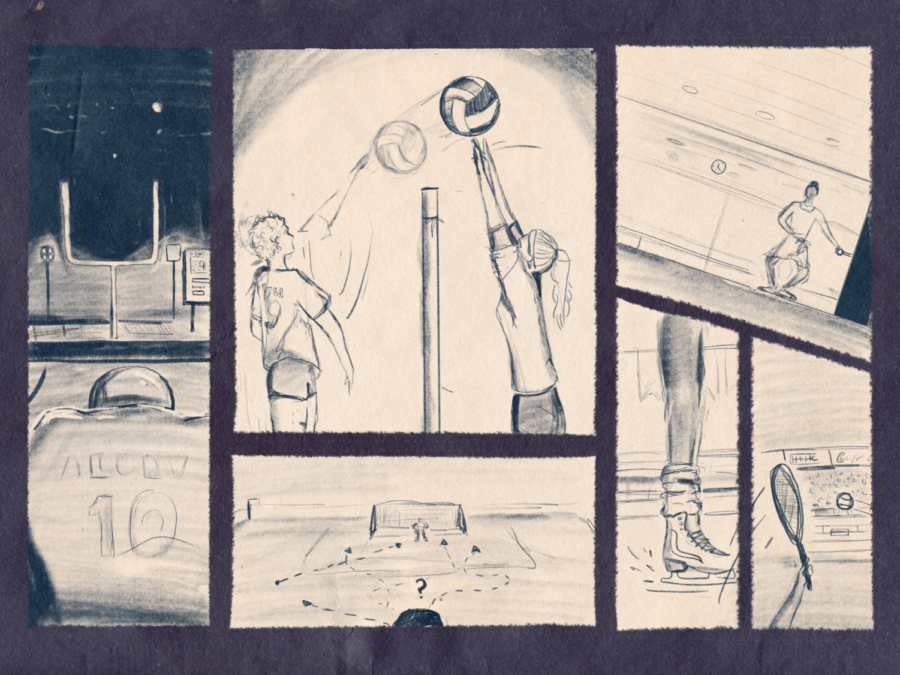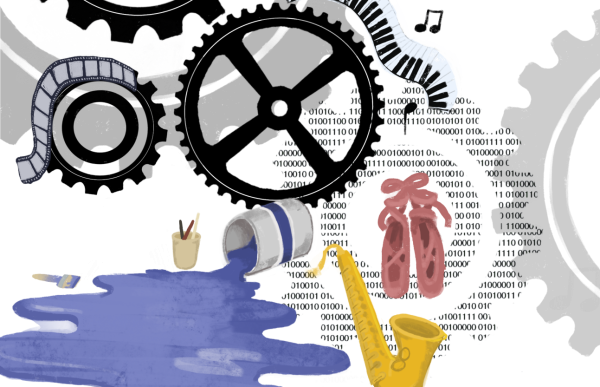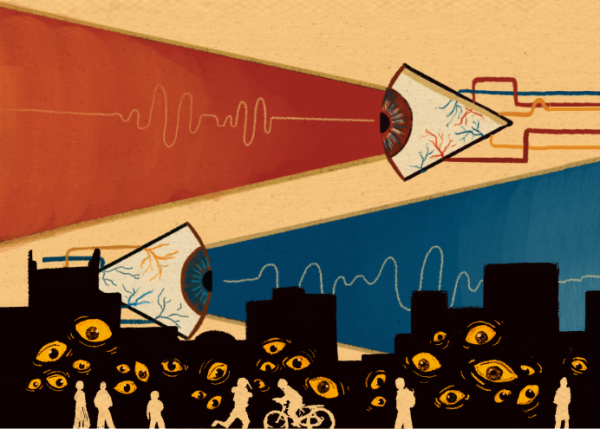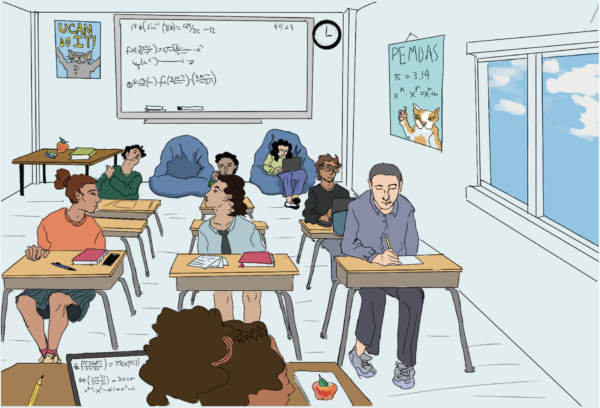Stressors in sports: the challenges student athletes face due to toxic cultures
For many ETHS students, sports are an integral part of the high school experience. They invigorate passion, build community, develop students’ character and create invaluable opportunities for countless athletes. However, with the many different messages sent to student-athletes, they can develop mental illness, eating disorders and other mental health concerns. Gender biases in sports can also play a huge role in the challenges student-athletes face, which leaves many feeling unfulfilled and unhappy within their sport. How are these problems with sports cultures intertwined, and what are we doing to combat them?
Due to the structure of many sports, mental health issues and disordered eating are frequent elements of the athlete experience, as one 2020 literature review found in the Journal of Eating Disorders.
According to sports psychiatrist Alan Currie, “There is strong and consistent evidence that eating disorders are prevalent in sport and especially in weight-sensitive sports such as endurance, weight category and aesthetic sports as well as jumping events.”
Figure skating, wrestling and dancing are just some of the sports that fall into this category.
“Definitely a lot of people [on my team] still struggle with eating disorders,” senior Caroline Klearman, who skates for the Evanston team not affiliated with ETHS, shares. “I’ve known probably six or seven girls who went to in-patient centers for them. I think it’s just so common that it’s not really shocking when someone goes away.”
There’s also some overlap with gender-based biases and the promotion of eating disorders and other self-image issues.
“When we would go to traveling competitions with our coaches, they’d regulate our diets. There are very different rules about what the girls could eat versus what guys could eat,” Klearman illustrates.
Another sport notorious for promoting restrictive diets is wrestling. In order to compete, wrestlers are entered into different weight classes, and they are weighed and tested for body fat through the program, which can encourage athletes to try to alter their weight in order to compete strategically.
“If you do have issues with eating or your body [image, then] stepping on the scale and seeing your weight every day [can be challenging],” senior wrestler Peter Wade explains. “Just having a number assigned that can make you feel either good or bad about yourself, I can see that being really tough.”
However, Wade shares he’s never felt pressure from his coaches or teammates to gain or lose weight for a competition.
“I don’t push a weight class on people,” boys and girls wrestling varsity head coach Rodolfo Salinas reinforces.
This highlights a stark contrast between these two weight-sensitive sports: the female-dominant sport practices regulation over the diets of athletes, whereas the male-dominant sport advocates for autonomy. Gender-based discrimination often runs rampant in many sports.
“I think with a lot of girl sports—I don’t know how it is with girl sports in the rest of the school, but with girls volleyball—I’ve heard stories from [fellow players] about how they just don’t appreciate misogyny coming from some of the male coaches,” junior volleyball player Isa de los Reyes explains.
Athletic director Chris Livatino acknowledges the different experiences student-athletes might have based on their gender.
“Just from years of doing this and hearing back from females that have been frustrated, I can tell you, I don’t think they do [have the same experience], and that’s a concern of mine, because I want [male and female athletes] to have the exact same experience.”
It is not uncommon for specific conflicts to arise within individual ETHS programs; however, the majority of sexism within spaces at ETHS is a consequence of a historically misogynistic culture.
“In general, women that play tennis are expected to be more reserved. John McEnroe was this famous tennis player, and when he would miss a shot or when the ump would make a bad call or whatever, he would slam his racket down. If I, tomorrow in a match, slammed my racket down, I would get kicked off the match,” senior tennis player Talia Berger-White expresses. “I haven’t seen the guys tennis team play in a while, but I am going to go out on a limb and say if they swore or slammed a racket, they’d just get a warning, [but if a girl player did that], people would be shocked that we acted that way. I just think that’s a preconceived bias and notion [that exists in] tennis in general; I don’t want to say specifically at Evanston, because it’s not specific to [just] Evanston.”
Although ETHS is not the root cause of this universal sexism, acknowledgement of the issue is still the first step towards progress. However, acknowledgement and actions based on acknowledgement can be varied as athletes and coaches can have different experiences throughout their athletic careers.
“I don’t think gender impacts the game of tennis,” girls varsity tennis head coach Leanne Baker, who played professionally for twelve years, shares.
Many student-athletes do experience sexism, whether intentional or not. Specific expectations for male and female athletes vary across sports, and frequently, the expectations for girls are more constraining.
“Girl dancers are supposed to have a very obvious amount of femininity and express that and work towards having the highest amount of femininity,” senior Moxie Dully describes the expectations placed upon her as a female-identifying dancer. “Male dancers don’t have to be as good to be as popular or as recognized because there are fewer of them, so female dancers have to try a lot harder.”
The evident gender biases and discrimination in sports influence mental health. Few studies have analyzed the psychological effects of sports in high school athletes according to gender, but a study conducted in 2011 by the Institute for Research in Medicine and Epidemiology of Sport located in France found that approximately 15.1 percent of male athletes had at least one behavioral or mental disorder as opposed to 20.2 percent of their female counterparts. The primary mental health concerns found in the studied women were anxiety, eating disorders, depression, sleep issues and self-harm.
Similarly, mental health disparities in gender impact the athletic experience of women and girls. According to PBS, approximately five to 10 million females experience eating disorders or disordered eating as opposed to one million males in the United States. Due to the mental and physical demands of sports, these disproportionate nutritional standards can inhibit the athletic performance and participation of women and girls in athletics, and when women and girls do partake in sports, their efforts are often rewarded less in comparison to those of male athletes. For example, dance—a historically female-dominated sport—frequently lacks the recognition of being a “real” sport.
“I think [dance] definitely gets a lot less respect, because people don’t see it as a sport,” Dully notes. “If anything, it can be harder than a lot of other [sports], because there’s an aspect of performance and an artistic aspect involved in it as well as the athleticism. But people don’t regard it as highly, because they think it’s just a silly little thing, not a legit working sport.”
Dully highlights a central disparity between male-dominant and female-dominant sports—the level of recognition and praise from viewership.
“I think historically boys sports have been looked at as expected to be better, expected to do better, where girls sports can be overlooked due to their gender, and as such expectations are lowered,” girls varsity volleyball head coach Paris McFall explains. “Oftentimes, the girls teams outperform the boys, but it’s not celebrated as much.”
Despite this wide history of sexism and discrimination, sports are always progressing and becoming more inclusive. For years, it was unheard of for a woman to engage in a sport like wrestling, but the wrestling team at ETHS is reconstructing this narrative.
“A young man can look at a young woman and be inspired and vice versa. Where it used to be like a man’s sport and [the girls] would be inspired by what the guys are doing. Now, a young man can look at one of our young ladies and be like, ‘She drove me to be better, because I saw her overcome. I saw her work hard.’ And that’s great,” says Salinas.
Last year, the wrestling program introduced a girls wrestling team; prior, female wrestlers were vastly outnumbered on a co-ed wrestling program. However, this new team has encountered obstacles with the lack of popularity surrounding the sport.
“Since [girls wrestling] is a new sport, there’s often not a lot of competition for girls, which is a big problem for them. There’s a lot of people eager to get on the mat, but they can’t necessarily find matches in different weight classes,” explained Wade.
This is another huge inclusion issue that needs awareness: not enough girls on sports teams. Nearly twenty years after World Wrestling Entertainment was founded, President Nixon passed a law called the Education Amendments Act of 1972. This law stated that sexual discrimination in any federal funded institution would be deemed illegal. Since then, nearly nine times as many girls are participating in high school sports than there were when this law was first put in action. However, schools across the country still have a long way to go towards gender equity in sports, especially one like wrestling. In fact, according to the National Wrestling Coaches Association, only 32 of the 50 U.S. states offer girls wrestling programs.
ETHS has recognized this pattern and has taken vital steps to include as many demographics as they can in sports and extracurriculars.
“We created Girls Play Sports, [a nonprofit run through ETHS], initially to address the issues that we wanted to get more girls participating in sports, and that was really successful and [we’re] learning from that experience,” Livatino shares.
Livatino also recognizes that discrimination in ETHS athletics is not isolated to gender, and despite ETHS’ diverse demographics, sports teams frequently lack reflectiveness of that.
“The current system that we have does not work, and it really creates a pay-for-play system, where if you’re a family that cannot afford to participate in sports when you’re in third and fourth grade, you’re kind of on the outside looking in, and you’ll never get there because by the time freshman year rolls around, [you’ll be behind],” Livatino discusses. “Most of our sports are extremely self-segregated. In most cases, it’s predominantly white, and if you look at the demographic numbers over the years, that hasn’t changed nearly as much as I would want it to have changed … You have to do something totally different much earlier on to change all that. I think we’ve got some really good ideas and plans for how to do that; it’s just about figuring out partners to make sure we can execute them. Before I retire, that’s my number one goal. I just want to figure that out, and then I can be happy.”
Recognizing the need for increased diversity within sport teams and working towards a more inclusive future has also been a large focus for many teams at ETHS. The volleyball program has historically been predominantly white. In an effort to change this, senior volleyball player Meg Houseworth as well as seniors and former volleyball players Margaret Adams and Cherie Animashaun created Volley4Change, a nonprofit organization that aims to introduce girls of color to volleyball prior to entering high school, free of cost.
“I think that’s really amazing that we’re in that environment with people who are always willing to coach everybody,” de los Reyes shares. “We’re slowly starting to introduce volleyball to everybody and be more inclusive.”
Former girls varsity volleyball head coach and current freshman B coach Liz Brieva has also helped to address the lack of diversity in the program by leading the program through discussions surrounding racial equity. Brieva is also a co-founder of Girls Play Sports and has helped as a volunteer coach for Volley4Change.
“I think we should really appreciate the work that Coach Brieva has done with trying to be more inclusive with volleyball. It’s not easy trying to do that. We, as a program, are trying to just improve as a team,” de los Reyes remarks.
With projects like Volley4Change and the effort that the wrestling team has put into giving all of their athletes the opportunity to perform, ETHS athletes have been able to really grow as individuals and unified teams. Improving as a team means that many coaches push for their athletes to learn valuable lessons that they can utilize for the rest of their lives, especially in the area of mental fortitude.
“[The coaches] push for trying your best and giving your all and [in] every sense like school and mental health and everything. They also push for mental strength like being able to take criticism and to not constantly critique yourself,” says Dully.
Mental and physical strength must be taught in a way that is positive and motivating so that athletes can grow their love for sports as they strengthen their athletic ability. If athletes are pushed too hard or don’t learn to think positively about themselves, teams can end their seasons burnt out and unmotivated. When coaches and players share an enjoyment of the sport, the effects can be very positive.
“I want my athletes to work hard for each other and for our team. But at the end of the day, the only way to really work as hard as possible is to enjoy what you are doing. If you are enjoying playing tennis, then the hard work comes naturally,” says Baker.
These lessons that are learned on an individual basis can positively impact the entire team.
“In order to be a great teammate, you have to be a solid, mentally tough person. I mean, it’s hard to get past mistakes and stuff like that, but if you are able to get past your own mistakes and bring yourself up, then you can bring your team up,” says de los Reyes.
High school athletics promote physical fitness, but with work, these teams become more than just an after school activity; they lead to a healthy culture of passionate and considerate athletes.
“It’s just a culture of having kids that are committed, being disciplined, and really caring about each other. You’re not going to win on Friday nights if you don’t care about your brothers and you don’t care about each other. That’s the number one thing I want in our coaches and guys. They care for each other, and we’ve got some kids that have been very selfless that are accepting their role, which is very important. Culture is everything,” says varsity football head coach Mike Burzawa.
All of the hard work that dedicated coaches bring to their practices and games leave their athletes with personal growth and a sense of pride.
“I think the culture is an energy and excitement about representing your school and about being [from] E-town,” says Livatino. “I think people are really proud to be athletes here.”
Your donation will support the student journalists of the Evanstonian. We are planning a big trip to the Journalism Educators Association conference in Nashville in November 2025, and any support will go towards making that trip a reality. Contributions will appear as a charge from SNOSite. Donations are NOT tax-deductible.












